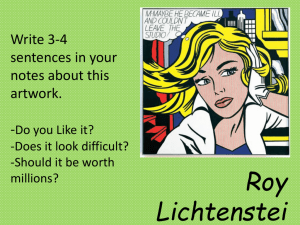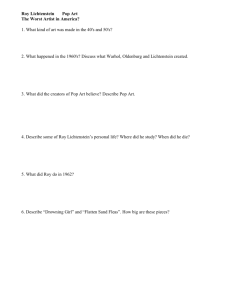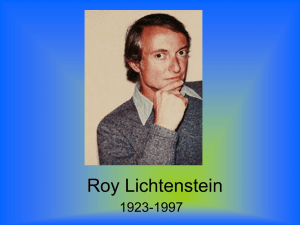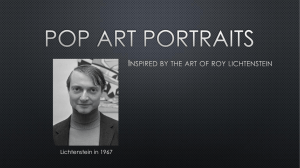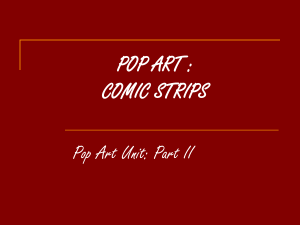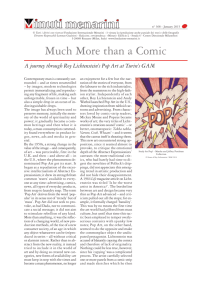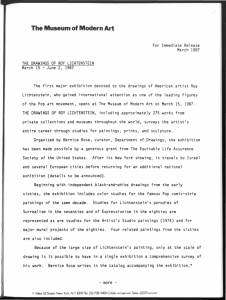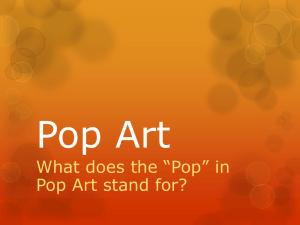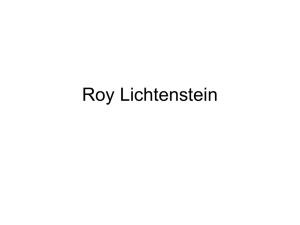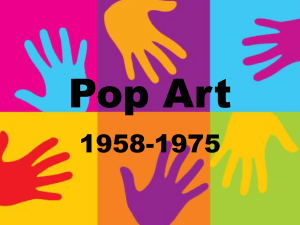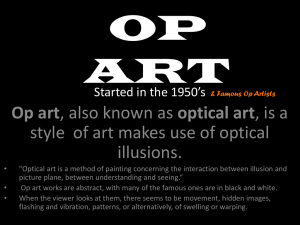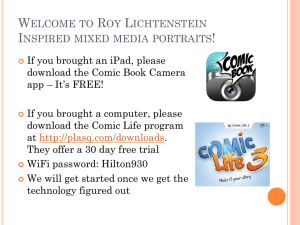Roy Lichtenstein - Waterford Public Schools
advertisement
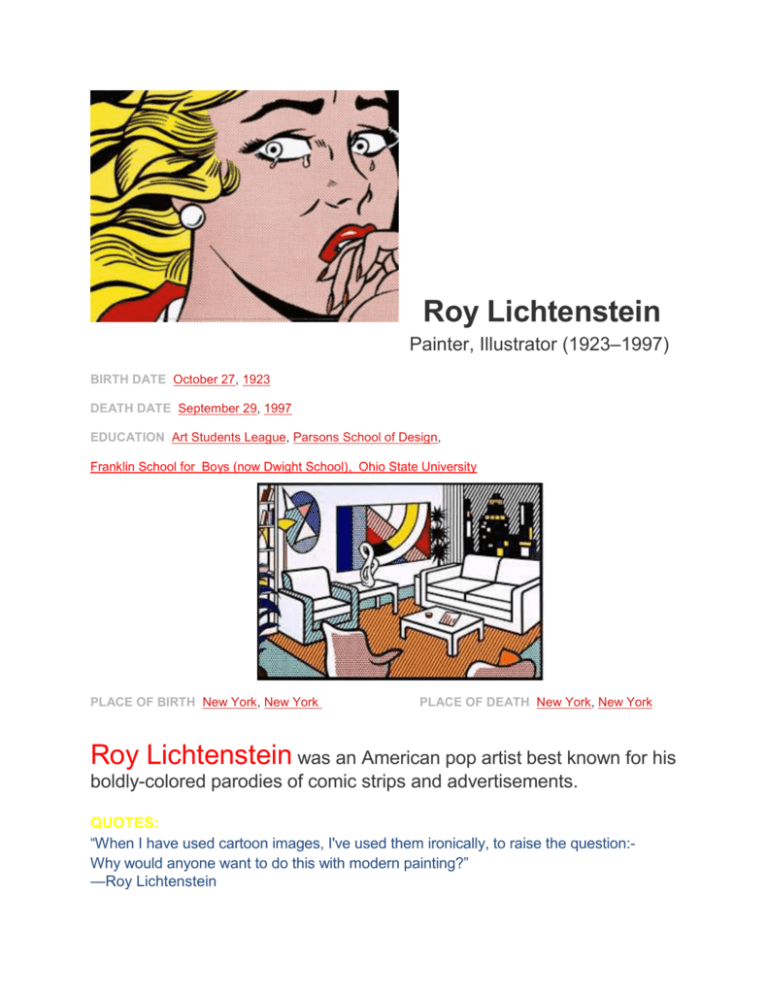
Roy Lichtenstein Painter, Illustrator (1923–1997) BIRTH DATE October 27, 1923 DEATH DATE September 29, 1997 EDUCATION Art Students League, Parsons School of Design, Franklin School for Boys (now Dwight School), Ohio State University PLACE OF BIRTH New York, New York PLACE OF DEATH New York, New York Roy Lichtenstein was an American pop artist best known for his boldly-colored parodies of comic strips and advertisements. QUOTES: “When I have used cartoon images, I've used them ironically, to raise the question:Why would anyone want to do this with modern painting?” —Roy Lichtenstein Synopsis American artist Roy Fox Lichtenstein was born in New York City on October 27, 1923, and grew up on Manhattan's Upper West Side. In the 1960s, Lichtenstein became a leading figure of the new Pop Art movement. Inspired by advertisements and comic strips, Lichtenstein's bright, graphic works parodied American popular culture and the art world itself. He died in New York City on September 29, 1997. Early Years Roy Fox Lichtenstein was born on October 27, 1923, in New York City, the son of Milton Lichtenstein, a successful real estate developer, and Beatrice Werner Lichtenstein. As a boy growing up on Manhattan's Upper West Side, Lichtenstein had a passion for both science and comic books. In his teens, he became interested in art. His college studies were interrupted in 1943, when he was drafted and sent to Europe for World War II. After his wartime service, Lichtenstein returned to Ohio State in 1946 to finish his undergraduate degree and master's degree—both in fine arts. He briefly taught at Ohio State before moving to Cleveland and working as a windowdisplay designer for a department store, an industrial designer and a commercial-art instructor. Commercial Success and Pop Art In the late 1940s, Lichtenstein exhibited his art in galleries nationwide, including in Cleveland and New York City. In the 1950s, he often took his artistic subjects from mythology and from American history and folklore, and he painted those subjects in styles that paid homage to earlier art, from the 18th century through modernism. Lichtenstein began experimenting with different subjects and methods in the early 1960s, while he was teaching at Rutgers University. His newer work was both a commentary on American popular culture and a reaction to the recent success of Abstract Expressionist painting by artists like Jackson Pollock and Willem de Kooning. Instead of painting abstract, often subject-less canvases as Pollock and others had had done, Lichtenstein took his imagery directly from comic books and advertising. Rather than emphasize his painting process and his own inner, emotional life in his art, he mimicked his borrowed sources right down to an impersonal-looking stencil process that imitated the mechanical printing used for commercial art. Lichtenstein became known for his deadpan humor and his slyly subversive way of building a signature body of work from mass-reproduced images. By the mid-1960s, he was nationally known and recognized as a leader in the Pop Art movement that also included Andy Warhol, James Rosenquist and Claes Oldenburg. His art became increasingly popular with both collectors and influential art dealers like Leo Castelli, who showed Lichtenstein's work at his gallery for 30 years. Like much Pop Art, it provoked debate over ideas of originality, consumerism and the fine line between fine art and entertainment. Later Career By the late 1960s, Lichtenstein had stopped using comic book sources. In the 1970s his focus turned to creating paintings that referred to the art of early 20th century masters like Picasso, Henri Matisse, Fernand Léger and Salvador Dalí. In the 1980s and '90s, he also painted representations of modern house interiors, brushstrokes and mirror reflections, all in his trademark, cartoon-like style. He also began working in sculpture. Lichtenstein was committed to his art until the end of his life, often spending at least 10 hours a day in his studio. His work was acquired by major museum collections around the world, and he received numerous honorary degrees and awards, including the National Medal of Arts in 1995. Personal Life and Death Lichtenstein married twice. He and his first wife, Isabel, whom he married in 1949 and divorced in 1967, had two sons, David and Mitchell. He married Dorothy Herzka in 1968. Lichtenstein died of complications from pneumonia on September 29, 1997, at the New York University Medical Center in Manhattan. Process 1. Research various ideas. Begin drawing thumbnail sketches to explore possible compositions. Thumbnail sketches are small (about4”x5”) to plan out background, middle ground and foreground, placement and proportions (size relationships). You should create at least 5 sketches of different compositions/subjects. 2. Discus with me your ideas. Choose a composition for your final project. 3. On newsprint, sketch a rough composition for the final resist. Distinguish major background areas. The newsprint will be used to mask areas when doing the resist patterning. For example, if a still life is the subject matter, you might sketch in a table, vase, and background wall. Then the newsprint will be cut apart, one piece at a time into these sections. 4. On the project paper, begin by brushing on any black outlines of the composition using the gloss medium and black acrylic mixture. Thick lines can be used, and tools can be used to scratch through the resist to add detail or texture. Allow to dry. 5. Brush the black resist onto a texture plate, and “stamp” the pattern onto the paper. Use the newsprint to shield areas that should not receive the patterned resist. Complete all of the texture plate resist stamping in this step. Allow to dry. 6. Finally, add bright, pop art color by brushing bright washes of watercolor on top of the resist. The gloss medium mixed with acrylic will resist the watercolor and retain its glossy look. National Core Arts Standards - Visual Arts Connecting Anchor Standard 11: Relate artistic ideas and works with societal, cultural, and historical context to deepen understanding.
